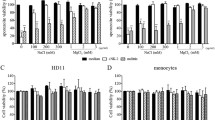Abstract
To understand the emergence and evolutionary selection of the efficient mechanisms of innate immunity it is necessary to accumulate knowledge about the structural and functional properties of antimicrobial peptides in different animal species. The cationic antimicrobial peptides, α-defensins, were isolated from leukocytic extracts of the lower narrow-nosed monkey, hamadryas baboon Papio hamadryas, using ultrafiltration, preparative electrophoresis and reverse-phase highperformance liquid chromatography. Analysis of the antimicrobial properties of α-defensins showed that they display a wide spectrum of antimicrobial activity, comparable with that of human α-defensin HNP1, and exert bactericidal and fungicidal effects at micromolar concentrations. A study of the influence of different medium conditions on antimicrobial activity of α-defensins revealed that a higher ionic strength or the presence of blood serum leads to a marked decrease in antimicrobial activity of α-defensins, while pH has no appreciable effect on it. We found that hamadryas baboon α-defensins are able to increase the permeability of the outer and inner membranes of E. coli, suggests that the bacterial membrane is one of the major targets of the antimicrobial effects of these peptides. The revealed differences in antimicrobial activity of α-defensins may result from their structural heterogeneity, which reflects different pathways of evolution of α-defensins in primates and underlies the selectivity of their antimicrobial effect.
Similar content being viewed by others
References
Kokryakov, V.N., Ocherki o vrozhdennom immunitete (Essays on Innate Immunity), St. Petersburg, 2006.
Lehrer, R.I. and Lu, W., α-Defensins in human innate immunity, Immunol. rev., 2012, vol. 245, pp. 84–112.
Zhu, S. and Gao, B., Evolutionary origin of β-defensins, Develop. Comp. Immunol., 2013, vol. 39, pp. 79–84.
Tang, Y.Q., Yuan, J., Osapay, G., Osapay, K., Tran, D., Miller, C.J., Ouellette, A.J., and Selsted, M.E., A cyclic antimicrobial peptide produced in primate leukocytes by the ligation of two truncated alpha-defensins, Science, 1999, vol. 286, pp. 498–502.
Leonova, L.E., Structural and functional properties of primate defensins, Vestnik SPbGU, ser. 3, Biol., 2009, pp.133–142.
Schneider, J.J., Unholzer, A., Schaller, M., Schäfer-Korting, M., and Korting, H.C., Human defensins, J. Mol. Med., 2005, vol. 83, pp. 587–595.
Lapin, B.A., Dzhikidze, E.K., and Fridman, E.P., Rukovodstvo po meditsinskoi primatologii (The Manual on Medical Primatology), Moscow, 1987.
Tsvetkova, E.V., Aleshina, G.M., Shamova, O.V., Leonova, L.E., Kokryakov, V.N., and Lehrer, R.I., α-Defensins from blood leukocytes of the monkey Papio hamadryas, Biochemistry (Moscow), 2006, vol. 71, pp. 879–883.
Stegemann, C., Tsvetkova, E.V., Aleshina, G.M., Lehrer, R.I., Kokryakov, V.N., and Hoffmann, R., De novo sequencing of two new cyclic theta-defensins from baboon (Papio hamadryas) leukocytes by matrix-assisted laser desorption/ionization mass spectrometry, Rapid Commun. Mass. Spectrom., 2010, vol. 24, pp. 599–604.
Pace, C.N., Vajdos, F., Fee, L., Grimsley, G., and Gray, T., How to measure and predict the molar absorption coefficient of a protein, Protein Sci., 1995, vol. 4, pp. 2411–2423.
Lehrer, R.I., Rosenman, M., Harwig, S.S.L., Jackson, R., and Eisenhauer, P., Ultrasensitive assays for endogenous antimicrobial polypeptides, J. Immunol. Methods, 1991, vol. 137, pp. 167–173.
Harwig, S.S.L., Chen, N., Park, A., and Lehrer, R., Purification of cysteine-rich bioactive peptides from leucocytes by continuous acidurea-polyacrilamide gel electrophoresis, Anal. Biochem., 1993, vol. 208, pp. 382–386.
Lehrer, R., Barton, A., Daher, K., Harwig, S., Ganz, T., and Selsted, M., Interaction of human defensins with Escherichia coli, Mechanism of bactericidal activity, J. Clin. Invest., 1989, vol. 84, pp. 553–561.
Tang, Y.Q., Yuan, J., Miller, C.J., and Selsted, M.E., Isolation, characterization, cDNA cloning, and antimicrobial properties of two distinct subfamilies of α-defensins from rhesus macaque leukocytes, Infect. Immun., 1999, vol. 67. pp. 6139–6144.
Tanabe, H., Yuan, J., Zaragoza, M.M., Dandekar, S., Henschen-Edman, A., Selsted, M.E., and Ouellette, A.J., Paneth cell α-defensins from rhesus macaque small intestine, Infect. Immun., 2004, vol. 72, pp. 1470–1478.
Bevins, C.L., Jones, D.E., Dutra, A., Schaffzin, J., and Muenke, M., Human enteric defensin genes: chromosomal map position and a model for possible evolutionary relationship, Genomics, 1996, vol. 31. pp. 95–106.
Varkey, J. and Nagaraj, R., Antibacterial activity of human neutrophil defensin HNP-1 analogs without cysteines, Antimicrob. Agents Chemother., 2005, vol. 49, pp. 4561–4566.
Panyutich, A.V., Hiemstra, P.S., van Wetering, S., and Ganz, T., Human neutrophil defensin and serpins form complexes and inactivate each other, Am. J. Respir. Cell Mol. Biol., 1995, vol. 12, pp. 351–357.
Author information
Authors and Affiliations
Corresponding author
Additional information
Original Russian Text © E.V. Tsvetkova, L.E. Leonova, G.M. Aleshina, O.V. Shamova, E.V. Romanovskaya, G.R. Mavropulo-Stolyarenko, V.N. Kokryakov, 2016, published in Zhurnal Evolyutsionnoi Biokhimii i Fiziologii, 2016, Vol. 52, No. 2, pp. 118—125.
Rights and permissions
About this article
Cite this article
Tsvetkova, E.V., Leonova, L.E., Aleshina, G.M. et al. Antimicrobial effects of α-defensins from leukocytes of the hamadryas baboon Papio hamadryas . J Evol Biochem Phys 52, 133–140 (2016). https://doi.org/10.1134/S0022093016020046
Received:
Published:
Issue Date:
DOI: https://doi.org/10.1134/S0022093016020046




